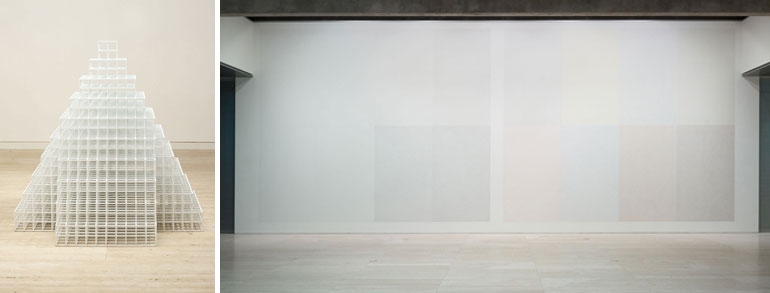
Sol LeWitt, (left) Pyramid 2005; (right) Wall drawing #337, Wall drawing #338 1971. John Kaldor Family Collection at the Art Gallery of NSW © Estate of Sol LeWitt/ARS. Licensed by Viscopy, Sydney
Sol LeWitt
USA, 1928–2007
LeWitt is considered an important figure in the minimalist generation and in establishing the groundwork for conceptual art, although he disclaimed both identifications. In his early years, he worked as a graphic artist and then a designer in architect IM Pei’s office, which helped him separate the idea of a design from its fabrication. His work uses systems derived from mathematics and is based on the premise that it is the concept that counts, regardless of whether it is realised.
LeWitt participated in a Kaldor Public Art Project in 1998.
Pyramid 2005
This sculpture seems to shift as you walk around. Made using a system of interlocking, equally-sized geometric shapes, the work shows LeWitt’s interest in repetition and seriality. Its structure echoes a type of pyramidal tower known as a ziggurat – an architectural form that LeWitt wrote an essay praising.
View Pyramid in the collection
Wall drawing #337, Wall drawing #338 1971
These two separate works are each subtitled Two part drawing. The wall is divided vertically into two parts. Each part is divided horizontally and vertically into four equal parts. 1st part: Lines in four directions, one direction in each quarter. 2nd part: Lines in four directions, superimposed progressively. From 1968, LeWitt created wall drawings based on little more than a couple of sentences describing the work’s structure and appearance, along with a diagram. Apart from some early works, he didn’t execute the drawings himself; installers completed them using the title instructions.
View Wall drawing #337 in the collection
View Wall drawing #338 in the collection
Installation of LeWitt’s wall drawings
Wall drawing #337 and Wall drawing #338 are installed in the Art Gallery of NSW in 2011.